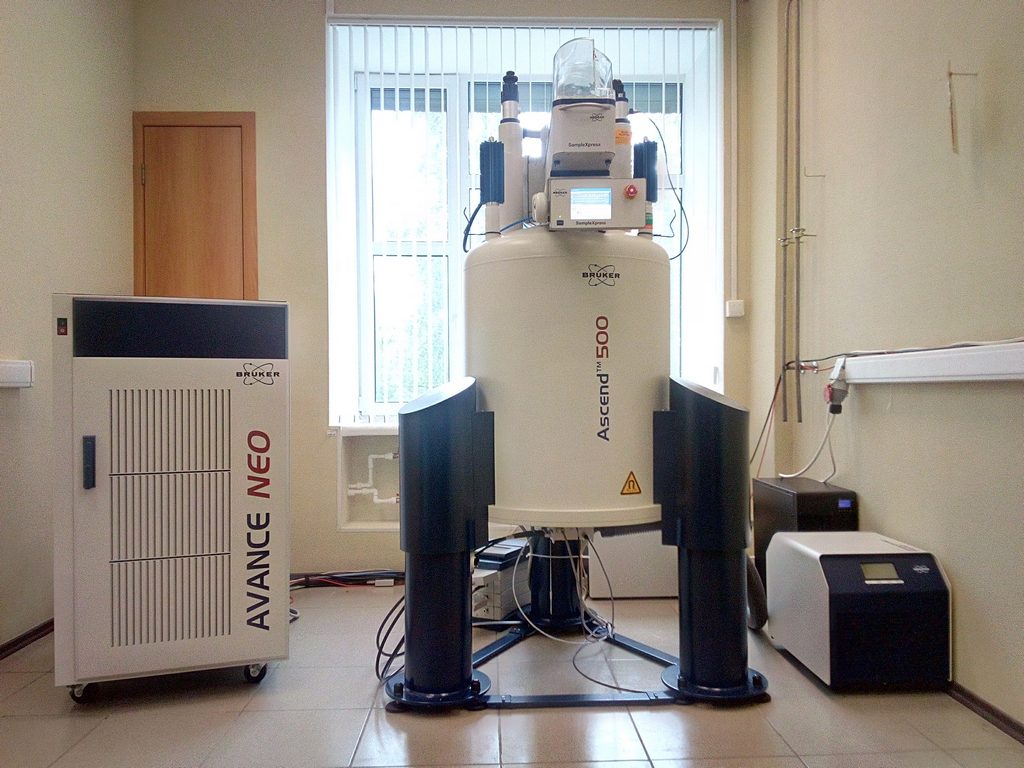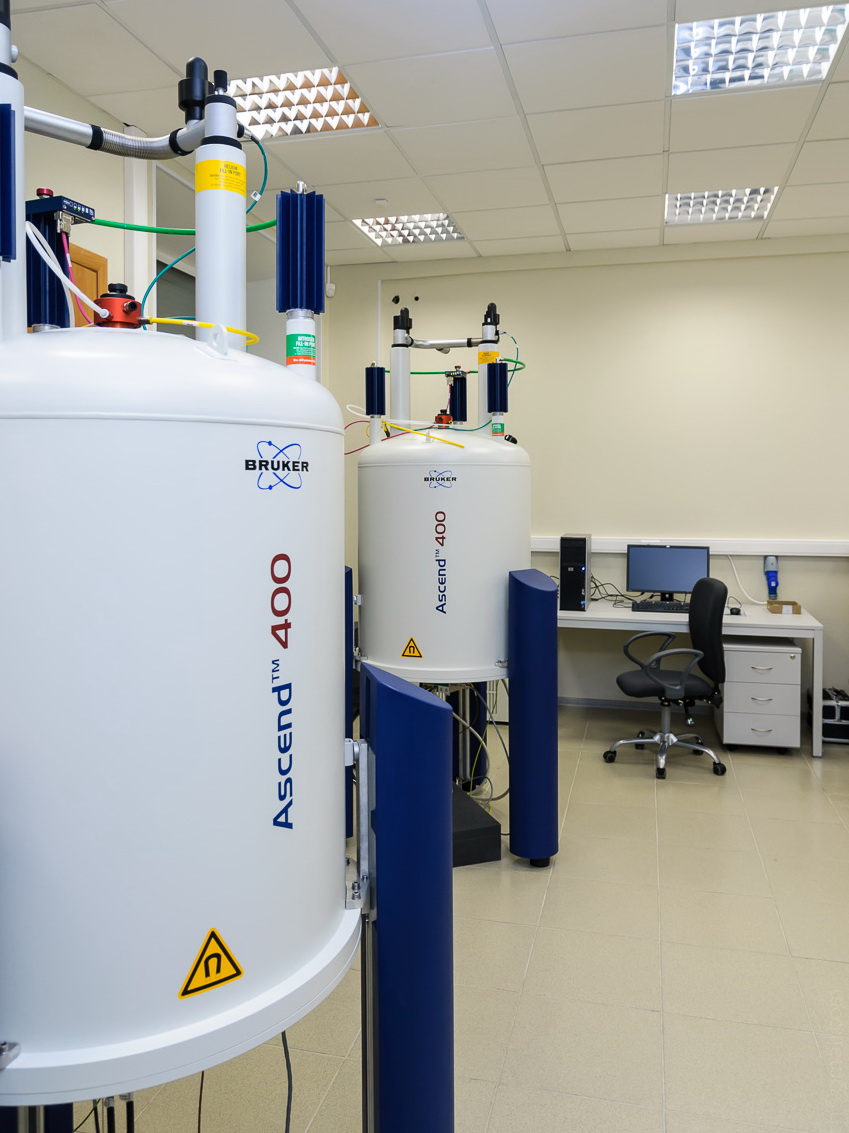Instruments_old
Bruker AVANCE NEO 500 MHz Three channel NMR spectrometer

This instrument provides broad analytical capabilities for solving non-routine problems related to physics and chemistry of condensed phase. Biomolecules (proteins, enzymes) and complicated organic molecules (polymers, natural compounds, steroids) could be studied.
The spectrometer is equipped with a broadband direct observation probe that allows one to measure NMR spectra on 1H, 19F, and in the range from 31P to 109Ag, as well as to study diffusion processes in liquid media.
The spectrometer is equipped with a Prodigy (BBO) broadband cryoprobe, which allows several times to reduce the time of lengthy heteronuclear NMR experiments and significantly reduces the waiting time for spectral data by users.
The most modern modification of the radio frequency unit – AVANCE NEO is based on a ‘transceive’ principle, meaning each NMR channel has both transmit and receive capabilities. So each channel is its own independent spectrometer with the full RF generation, transmission and receive infrastructure. This architecture provides the greatest flexibility in terms of instrument configuration and multi-channel operation. Multi-receive experiments are easily implemented with this new approach.
The three-channel arrangement of the new device makes it possible to carry out the widest range of modern NMR studies.
The spectrometer is controlled by the latest version TopSpin 4 software, which opens up the possibility of applying the latest achievements in the processing and analysis of spectral data.
Available probeheads
Bruker Avance III 500 MHz Three channel NMR spectrometer
|
 |
This spectrometer is suited for the measurements of 1D, 2D and 3D NMR spectra of liquids and solutions. The equipment provides a broad range of analytical capabilities to solve non-routine problems from fields of chemistry and physics of condensed phase. Biomolecules (proteins, enzymes) and complicated organic molecules (polymers, natural compounds, steroids) could be studied.
- Long measurements at low temperature (down to 110 K)
- Three-channel architecture (from 1H to 109Ag)
- Diffusion measurements at temperatures up to 470 K
- Planned: combined NMR/UV-vis spectroscopy
- Planned: measurements in liquefied gases as solvents
|
|
Available probeheads
|
Bruker Avance III 400 MHz widebore Three channel Solid State NMR spectrometer with MRI/Diffusion capability
|
 |
This NMR spectrometer is designed to study samples in solid state: crystallines, powders, weakly ordered materials, gels, liquid crystals, amorphous compounds, nanostructures (zeolites, silicates) etc. Wide bore of the magnet and advanced set of probes allows one to study diffusion processes, obtain micro-tomographic images, record high resolution spectra with magic angle spinning etc.
- Long low- and high-temperature measurements (from 130 to 870 K)
- Microtomography (with small animal heartbeat and pulse monitoring unit)
- Magic angle spinning up to 24 kHz
- Diffusion measurements (gradients up to 3000 G/cm)
- Planned: studies of monocrystals
|
|
Available probeheads
|
Bruker 300 MHz DPX and two Bruker 400 MHz Avance III spectrometers for routine measurements
|
 |
These spectrometers are dedicated to perform routine measurements of 1D and 2D NMR spectra. They cover significant portion of demands for a fast-analysis of composition and purity of chemical compounds and reaction kinetics studies, allowing one to investigate final and intermediate products of chemical reactions. The measurement procedure is partially automated.
- Direct and inverse detection probes
- Observed nuclei range from 1H to 109Ag
- Possible 1H{19F} and 19F{1H} measurements
- Possible 2H{19F} measurements
- Temperature range from 110 to 430 K
|
Bruker Elexsys E580 EPR spectrometer
|
 |
Bruker Elexsys E580 EPR spectrometer is a setup working at 9400 MHz, (3.2 cm wavelength, X-band) suited for studies of paramagnetic centers (PC) in solids, liquids, solutions and gases. Measured spectroscopic characteristics are g-factors, lineshapes and relaxation parameters in a wide temperature range. Experimental complex is capable to determine electronic state of PCs, their location in a crystal lattice, crystal field anisotropy and super-fine interactions between unpaired electrons and nuclei. It is possible to study isotopic composition of PCs and their interaction with adjacent ions, to investigate the presence and type of magnetic interactions etc. Spectrometer is equipped with additional modules allowing one to conduct ENDOR (Electron Nuclear DOuble Resonance) and TRIPLE experiments in order to investigate direct and indirect exchange interactions. |
The spectrometer is equipped with 11000 G electromagnet and is capable of measurements in CW-regime as well as in FT-regime. Spectral acquisition and processing is performed with the help of Aepr, FDepr and Xepr software packages. For studies of monocrystals the spectrometer is equipped with a goniometer. Absolute measurements of frequency and power of MW-radiation, and magnetic field strength are possible
- 100 W UV-irradiation of the sample inside resonator in the wavelength range 200-2000 nm
- ENDOR/TRIPLE measurements controlled by two 1-400 MHz generators with 200 ns switch time of phase, amplitude and frequency
- Magnetic field strength measurements from 1500 to 15000 G
- Temperature range from 3.7 K to 500 K
- Planned: installation of field gradients coils for tomographic measurements
- Planned: extending working range to L-band (1000 MHz, 32 cm) and W-band (90000 MHz, 10 mm)
|
Tecmag Redstone NQR spectrometer
|
 |
NMR/NQR spectrometer Tecmaq Redstone is an universal multi-pulse spectrometer working in the frequency range 1-550 MHz allowing one to obtain spectral and relaxation NMR and NQR parameters. Spectrometer is suited for the study of crystalline, polycrystalline as well as magnetically ordered systems with the sample size from 5 to 10 mm. Investigation of orientation dependence is possible for monocrystals.
- The observed frequencies in a zero external magnetic field 1-500 MHz.
- Temperature range from 4 K to 400 K.
- Acquisition of weak NQR signals by multiple scans.
- NQR spectra 35Cl, 63Cu, 65Cu, 75As, 93Nb, 183Ta etc nuclei.
- NMR of nuclei included in the magnetically ordered compounds such as 11B, 57Fe, 59Co, 61Ni, 187Os and others.
- Investigation of an orientation dependence for monocrystals.
|





